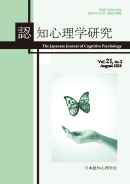Current issue
Displaying 1-7 of 7 articles from this issue
- |<
- <
- 1
- >
- >|
Original Articles
-
2024 Volume 21 Issue 2 Pages 47-58
Published: February 29, 2024
Released on J-STAGE: April 02, 2024
Download PDF (660K) -
2024 Volume 21 Issue 2 Pages 59-65
Published: February 29, 2024
Released on J-STAGE: April 02, 2024
Download PDF (513K) -
2024 Volume 21 Issue 2 Pages 67-77
Published: February 29, 2024
Released on J-STAGE: April 02, 2024
Download PDF (457K)
Review
-
2024 Volume 21 Issue 2 Pages 79-99
Published: February 29, 2024
Released on J-STAGE: April 02, 2024
Download PDF (846K)
Research Report
-
2024 Volume 21 Issue 2 Pages 101-109
Published: February 29, 2024
Released on J-STAGE: April 02, 2024
Download PDF (495K)
-
2024 Volume 21 Issue 2 Pages 111-112
Published: February 29, 2024
Released on J-STAGE: April 02, 2024
Download PDF (208K)
-
2024 Volume 21 Issue 2 Pages 113-116
Published: February 29, 2024
Released on J-STAGE: April 02, 2024
Download PDF (234K)
- |<
- <
- 1
- >
- >|
